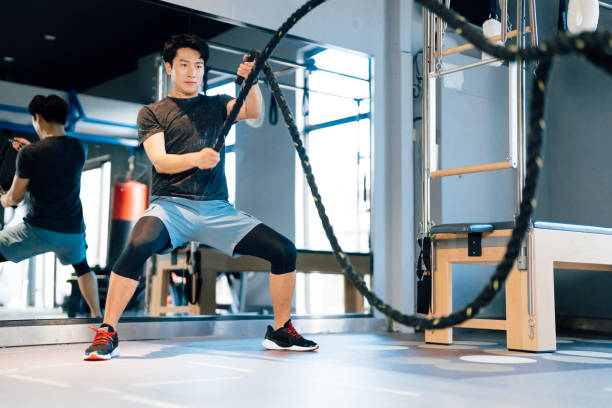Introduction
High-Intensity Interval Training (HIIT) has become a popular workout method due to its efficiency and effectiveness. This comprehensive guide will delve into the benefits, methods, and science behind HIIT, offering insights to help you incorporate this dynamic training style into your fitness routine.
What is High-Intensity Interval Training (HIIT)?
High-Intensity Interval Training (HIIT) is a type of exercise that alternates between short bursts of intense activity and periods of lower-intensity recovery or rest. These intervals are designed to push your body to its limits during the high-intensity phases and allow it to recover during the low-intensity phases. The result is a highly efficient workout that maximizes calorie burn and improves cardiovascular fitness in a shorter amount of time compared to traditional workouts.
Benefits of High-Intensity Interval Training (HIIT)
Efficient Use of Time
One of the primary advantages of High-Intensity Interval Training (HIIT) is its time efficiency. HIIT workouts typically last between 15 to 30 minutes, making it ideal for individuals with busy schedules. Despite the shorter duration, HIIT is known for its effectiveness in burning calories and improving overall fitness.
Boosts Metabolism
High-Intensity Interval Training (HIIT) can significantly boost your metabolism. The intense bursts of activity elevate your heart rate and increase the calories burned both during and after the workout. This post-exercise effect, known as excess post-exercise oxygen consumption (EPOC), means your body continues to burn calories at a higher rate even after you’ve finished exercising.
Enhances Cardiovascular Health
Regular engagement in High-Intensity Interval Training (HIIT) has been shown to improve cardiovascular health. By pushing your heart rate to higher levels, HIIT strengthens your heart and improves blood circulation. This can lead to better endurance and a reduced risk of heart disease.
Improves Insulin Sensitivity
HIIT can enhance insulin sensitivity, which is crucial for maintaining healthy blood sugar levels. Studies have demonstrated that incorporating (HIIT) into your routine can help regulate insulin levels and reduce the risk of type 2 diabetes.
Builds Muscle and Burns Fat
(HIIT) is effective for both building muscle and burning fat. The intense nature of the workouts stimulates muscle growth while also promoting fat loss. This combination helps achieve a leaner and more toned physique.
How to Get Started with High-Intensity Interval Training (HIIT)
Choosing the Right Exercises
When starting with (HIIT), it’s essential to choose exercises that you can perform with high intensity. Bodyweight exercises such as squats, burpees, and jumping jacks are excellent options. You can also incorporate equipment like kettlebells or resistance bands for added variety.
Structuring Your HIIT Workout
A typical (HIIT) workout consists of a warm-up, several intervals of high-intensity exercise followed by rest periods, and a cool-down. A common ratio for intervals is 1:2, where you work intensely for 30 seconds and rest for 60 seconds. Adjust the intervals based on your fitness level and goals.
Safety Tips for HIIT
While High-Intensity Interval Training (HIIT) is generally safe, it’s important to listen to your body and avoid overtraining. Start with shorter, less intense intervals and gradually increase the intensity as your fitness improves. Ensure you perform exercises with proper form to prevent injuries.
Common Misconceptions About High-Intensity Interval Training (HIIT)
HIIT is Only for Advanced Athletes
One common misconception about (HIIT) is that it’s only suitable for advanced athletes. In reality, HIIT can be modified to suit various fitness levels. Beginners can start with less intense exercises and longer rest periods before gradually increasing the intensity.
HIIT is Too Hard on the Joints
Another misconception is that HIIT is too hard on the joints. While HIIT can be intense, it doesn’t necessarily mean it will harm your joints. Opt for low-impact exercises or modify movements if you have joint concerns, and always focus on proper form.
You Need Specialized Equipment for HIIT
Many people believe that (HIIT) requires specialized equipment. However, many effective HIIT workouts use only bodyweight exercises or minimal equipment. Exercises like running, cycling, and jumping rope can be performed with little to no equipment.
Conclusion
(HIIT) offers a versatile and time-efficient approach to fitness. By incorporating short bursts of intense activity with recovery periods, HIIT delivers numerous health benefits, including improved cardiovascular health, increased metabolism, and enhanced muscle tone. Whether you’re a seasoned athlete or a beginner, HIIT can be adapted to meet your fitness needs and help you achieve your goals.
FAQs
How often should I do High-Intensity Interval Training (HIIT)?
It’s recommended to do HIIT workouts 2-3 times a week, allowing for rest days in between to prevent overtraining and injury.
Can beginners do High-Intensity Interval Training (HIIT)?
Yes, beginners can start with modified HIIT workouts that include lower-intensity exercises and longer rest periods. Gradually increase the intensity as you build strength and endurance.
How long should a HIIT workout last?
A typical High-Intensity Interval Training (HIIT) workout lasts between 15 to 30 minutes, including warm-up and cool-down.
Is it necessary to use equipment for HIIT?
No, High-Intensity Interval Training (HIIT) can be performed with bodyweight exercises alone. Equipment is optional and can be used to add variety to your workouts.
Can HIIT help with weight loss?
Yes, High-Intensity Interval Training (HIIT) is effective for weight loss due to its ability to burn calories and boost metabolism. Combined with a healthy diet, HIIT can help achieve weight loss goals.
